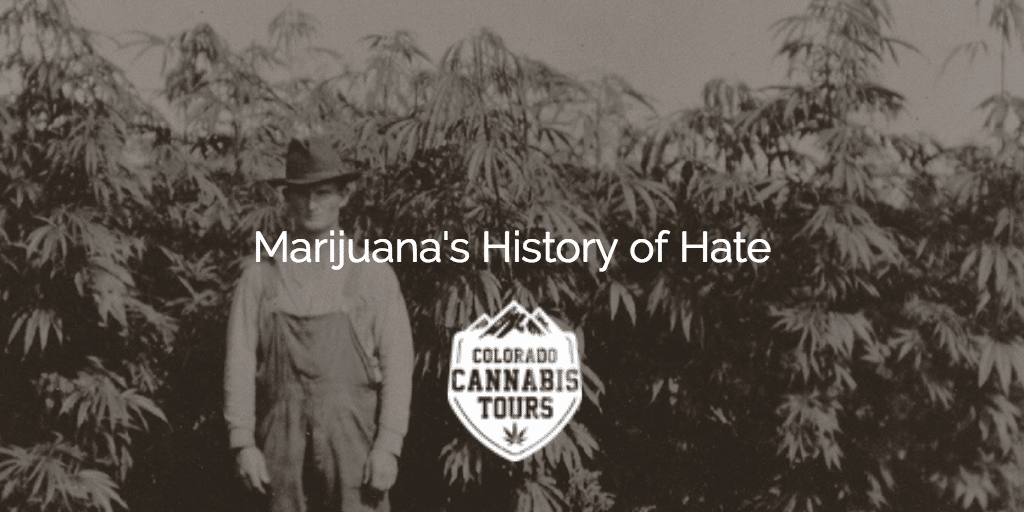
Dating all the way back to the early 1600’s the marijuana (hemp) plant has been available in America.
As far as we know, the history of cannabis, could pre date our records.
Colonists used the plant for the creation of essential items such as; cloth, canvas, rope, food incense and much more.
In 1619 the Jamestown Colony in Virginia went as far mandating all farmers to grow hemp due to its useful qualities.
Shockingly, cannabis was SO important that, in Mid-1700’s you could be jailed for not growing hemp!
Also interesting, in those day, you could use hemp as a form of legal tender.
The government even allowed its citizens to pay taxes with hemp.
In the 1850s there were over 8,000 hemp plantations growing hemp for cloth, canvas and even the cordage used for baling cotton.
Somehow, come early 1900s, America’s view on the hemp plant changed DRASTICALLY, for the worse.
Debates over the legalization of cannabis plant and the use of “marijuana” has been going on ever since.
What caused the hemp plant to change from an INCREDIBLY useful crop, to a Schedule 1 drug, in the short span of 100 years?
Here is a look at the underlying themes and key players in the evolution of the hemp plant’s story in the United States.
What “racism” really the “core” cause of making cannabis illegal?
In the early 1900s a Mexican clash between General Perishing’s Army and the bandit Pancho Villa caused many Mexicans to cross the border and immigrate to the United States.
Large plantation owners took advantage of the situation by hiring the new wave of Mexican immigrants as cheap labor to work on their farms.
This created resentment from small farm owners and the American workers who were kicked out of a job during the Great Depression.
American’s wanted a “Scapegoat” for their misfortune and the Mexican people paved the way to provide exactly what America was looking for.
A few of the distraught farmers noticed that the Mexican immigrants used the hemp plant for medicinal and recreational purposes, by smoking a substance called “marihuana.”
Marihuana, originally spelled with an “h,” went on to be the “blame” for the apparent strangeness of the behaviors of the Mexican culture.
Any and all strange behaviors, fugitive acts and overall criminal actions all were blamed on the use of this “new drug,” termed marihuana by politicians, seeking to control.
Before long, all of the Western States, whose workers were being replaced by these Mexican immigrants, began to ban the substance and the negative connotation of the Mexican immigrants became associated with the use of marijuana.
While the western states were blaming marijuana for the negative effects of increased Mexican immigration, the eastern states had a different experience.
Of course, the Latin American immigration affected the east as well, but they also associated marijuana use with the rise of popular black jazz musicians.
Marijuana was an indispensable part of the Jazz music scene in the 1900s.
Those who did not appreciate the African American’s rise to fame began to associate use of the drug with bad behaviors.
They believed that Marijuana gave black’s the courage to stand up to white people and helped in the seducing of white women, among other HIGHLY inappropriate connections, we will abstain from reporting.
People who feared racial equality and the new wave of Latin American immigration began to view marijuana as the fuel of change.
Have you ever known cannabis to trigger “violence” in any single consumer?
During the early 1900s, the use of Marijuana became associated with violent behaviors.
This belief stemmed from the history of Marco Polo’s hasashin’s, derived from the word assassin.
Professional killers were given large doses of hashish in order to experience the bliss that awaited them after fulfilling the terms of their mission.
After the effects of the hash wore off, the hasashin would complete their mission and remain loyal to the individual ordering the mission.
In the 1930s, the story changed from marijuana being the source of loyalty, to marijuana being the source of assassination.
A medical journal published an article that claimed hashish would cause its users to go mad with rage and kill anyone they could get their hands on.
While there was no proof of this effect of marijuana, the article instilled fear in the American people and lawmakers.
The Original Dynamic Hemp Hating Duo
Harry J. Anslinger and William Randolf Hearst, used the new fear of the hemp plant to advance their careers and ultimately alter the course of marijuana’s history.
Harry J. Anslinger was a career bureaucrat who was a member of the Bureau of Narcotics.
He realized that opiates and cocaine alone would not be enough to establish the Bureau of Narcotics as an important government agency.
Therefore, he made it his goal to make marijuana illegal on the federal level.
He drew on the themes of racism and violence to insight negative connotations with the use of marijuana.
In the 1930s, Anslinger was named director of the bureau and thus began a serious push for the illegalization of marijuana.
William Randolf Hearst, a big advocate for yellow journalism and owner of the San Francisco Examiner, benefitted from the illegalization of weed.
A combination of hatred for Mexicans (he lost over 800,000 acres of timberland to Pancho Villa), investment in the timber industry (hemp paper was being considered as an alternative to paper made from wood) and profit from the embellished stories about marijuana, led to Hearst being a strong advocate for the illegalization of hemp.
Hearst’s publishing of outrageous stories about the negative effects of marijuana and Anslinger’s bureaucratic success all played a vital role in the Marijuana Tax Act of 1937.
The Act effectively banned the use and sales of all hemp related products.
While the Act was eventually ruled unconstitutional, it gave way to over half a century of legislation aimed at preventing the use and sales of marijuana.
Sources:
https://druglibrary.org/
https://www.attn.com/stories/
https://www.drugwarrant.com/
- What Is CHS? – Cannabis Hyperemesis Syndrome Heal The Mind With Information To Cure The Body Of Dis-Ease - May 17, 2021
- Marijuana’s History Of Hate - March 27, 2017
- Legalizing Marijuana Has Affected Drug Cartels - March 16, 2017
